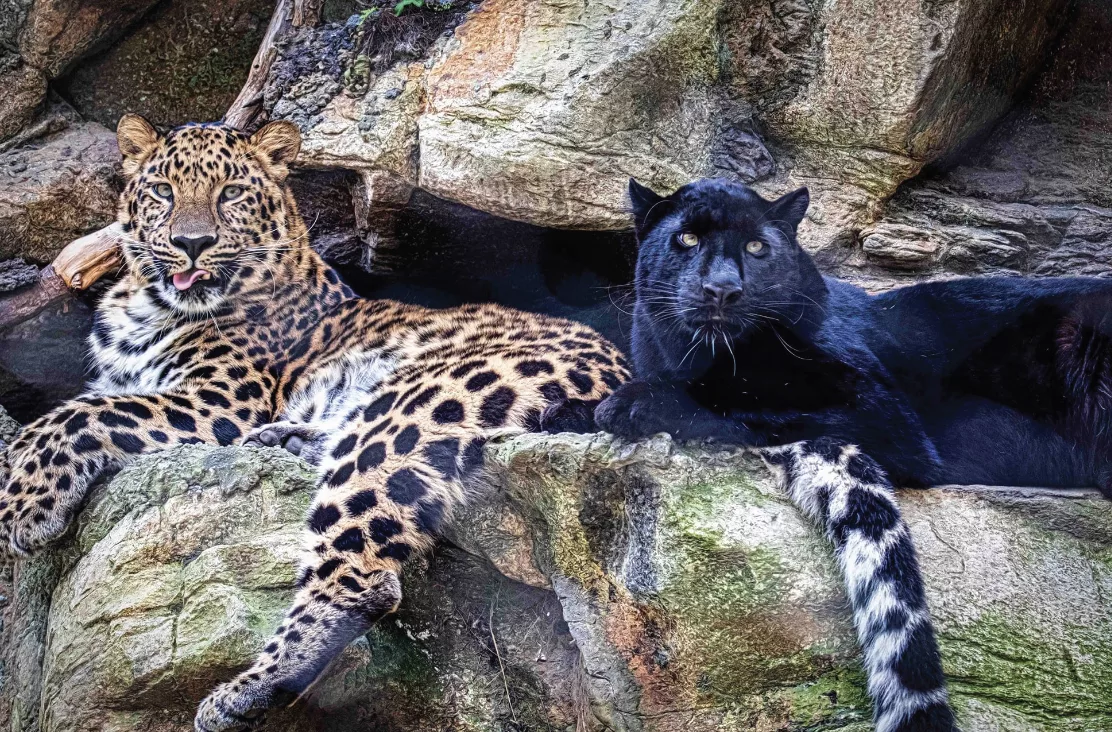
By Jim Knox
Most guests to Connecticut’s Beardsley Zoo don’t see her at first. This temporary “invisibility” is not a result of ignorance, nor is it the result of a fleeting attention span. The reason most folks cannot see the great cat mere feet away is largely due to her appearance and stealthy behavior. Leopards—practically by definition—are among the planet’s stealthiest creatures. Yet Kallisto, our female Amur leopard (Panthera pardus orientalis), has an extra stealth advantage.
As a cat born with a rare mutation known as melanism, Kallisto stands out…once you finally see her. Melanism, or an overabundance of pigment known as melanin, can occur in many species of vertebrates. This overabundance of dark pigment produces fur, feathers, skin, or scales with a blackish hue. A common expression of this mutation are the “black” Gray squirrels seen throughout Fairfield County and many regions of our state.
In the case of leopards, this mutation occurs approximately 10% of the time, with 90% of leopards sporting black-spotted golden coats with white bellies. What’s more, this dark coloration can become established in certain populations and virtually absent in others. Evolutionary biologists theorize that dark coat color is a result of a process known as adaptive selection—aiding these big cats in thermoregulation and in hiding among the shadows of the dense lush forests of Africa and Asia. Among Amur leopards, which are native to the high latitudes and snowy wilderness of the Russian Far East, this complete head-to-toe-and-tail blackish coloration is not considered to be advantageous and is thus, much rarer, occurring in less than 1% of Amur leopard births.
When guests to Connecticut’s Beardsley Zoo finally spy Kallisto, they see what they describe as a black panther. Yet, a careful look in full daylight reveals the full beauty of this magnificent creature as the cryptic yet distinct pattern of her spotted rosettes begins to emerge to the trained eye. As she moves, the gloss of her coat reflects the light, while the rosettes absorb the light, revealing a stunning pattern hidden within the coat. Each leopard possesses a unique pattern of rosettes just as each one of us possesses unique fingerprints.
Such black leopards are almost always born with golden-coated littermates (Kallisto was born with her golden coated brother, Orion). So, is she a leopard or a Black panther? In a sense, she is both. The term panther is generic and is commonly used to describe multiple species of great cats, but most commonly refers to leopards, jaguars, and Mountain lions (which to add to the confusion are known by more than two dozen regional names throughout the Western Hemisphere). To further obscure this confusion, only the leopard and jaguar have been recorded as exhibiting melanism. This coloration is often seen in leopards and jaguars, leading many observers to believe they are seeing a single species. So, while there is no species known as a “Black panther,” observers of these beautiful creatures are correct in their observation that they are seeing a panther that is effectively a black-coated cat.
In every biological respect, these cats are the same as their golden-coated siblings, yet “Black panthers” possess something far more than merely unusual coat coloration. By virtue of this “cloaking” appearance, these great beasts are shrouded in mystery and ascribed powers by cultures on four continents over the millennia.
Once detected—their appearance rivets our gaze. With nightshade coloration defining their lithe forms, we discern the fine detail of their muscular frames and the graceful fluidity which animates their movements. With palpable power that we practically feel with each pad of their lethal paws, these mythic beasts glide seamlessly from their world into ours. In Black panthers we have creatures who beckon us to a wilder timeless world—one inhabited by their ancestors and ours. As the very embodiment of the wild, these great cats are the mystery and the power inhabiting the forests of our minds.
So, what can we learn from these ethereal phantoms of the dense wild forests of the world? How can we emulate them? Rare, bold, self-reliant, ever-patient, decisive, and successful, the Black Panther possesses a host of enviable traits. Just like the great Black panthers, we are unique individuals who all possess undeniable elements of beauty and power we can share with the world around us. Though we may keep these traits hidden beneath a cryptic exterior, such beauty and power capture the attention of those few who have the patience and vision to see what eludes the gaze of so many.
Jim Knox is Curator of Education at Connecticut’s Beardsley Zoo where he directs education and conservation initiatives to advance the protection of wildlife in Connecticut and beyond.

